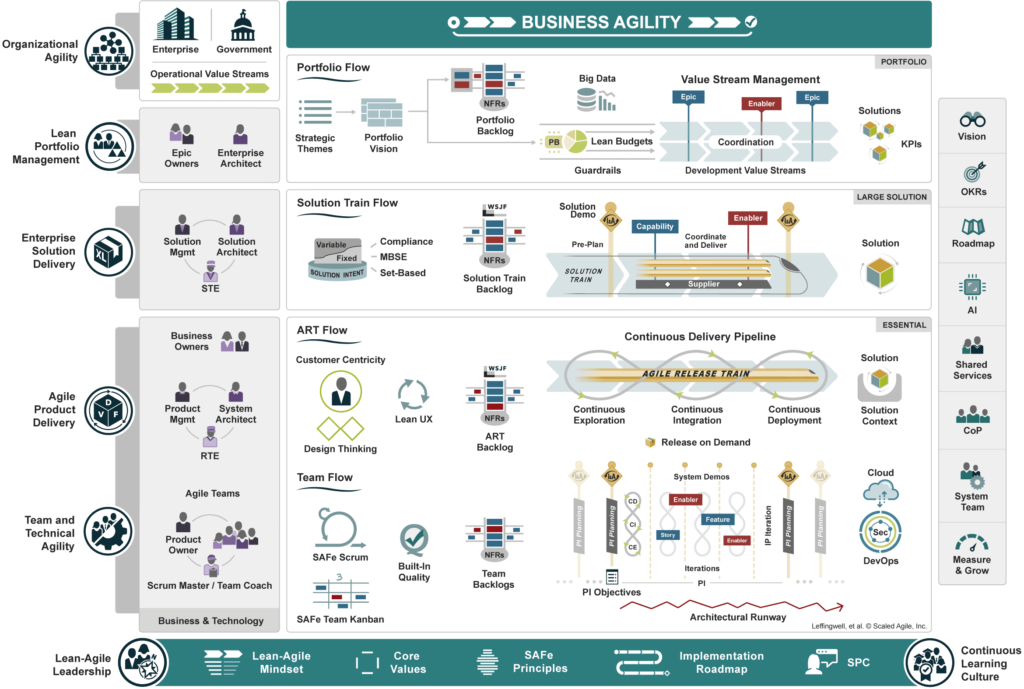
Agile at Scale: Mastering Complex Projects
Agile methodologies have become crucial in IT and project management. As organizations face complex projects, they must implement agile at a larger scale effectively.
In this guide, we will explore the world of agile at scale, examining its benefits, challenges, and different approaches developed to meet the demands of large-scale projects.
Whether you are a project manager, a software developer, or an executive overseeing such projects, you must grasp applying agile principles at scale to attain success.
Agile at Scale: Addressing the Growing Needs
As businesses grow and undertake larger, complex projects, they encounter challenges in accommodating scaling needs within traditional agile methodologies.
Smaller projects with co-located teams and stable requirements have shown the effectiveness of traditional agile methodologies like Scrum or Kanban. However, when dealing with larger project scopes, especially with distributed teams and significant interdependence, scaling agile becomes necessary.
Challenges of Traditional Agile in Large Projects:
Traditional agile methodologies offer numerous advantages but face specific challenges when applied to large-scale, global projects. These challenges include:
- Lack of Synchronization: In large-scale projects, achieving synchronization across multiple teams becomes complex, making it difficult to ensure consistent progress and alignment towards project goals.
- Scaling Collaboration: When teams are geographically dispersed, facilitating effective collaboration becomes more challenging, hindering productivity and innovation.
- Managing Dependencies: In big global projects, multiple teams often have interdependencies, and without proper coordination, delays and conflicts can arise, leading to project bottlenecks and inefficiencies.
SAFe: A Framework for Scaling Agile
The Scaled Agile Framework (SAFe) has emerged as a leading industry framework to address the challenges of scaling agile.
SAFe offers organizations a comprehensive and structured approach to scaling agile practices.
SAFe incorporates key elements such as Agile Release Trains (ARTs), which are long-lived teams that incrementally deliver value. It also includes Program Increment (PI) planning, an approach based on cadence for planning and execution. The role of the Agile Release Train Engineer (RTE) is crucial in facilitating the effective functioning of ARTs.
Implementing SAFe enables organizations to improve coordination, alignment, and visibility across teams, resulting in enhanced productivity and value delivery.
The Other Side of the Coin
The comprehensive nature of SAFe can require a significant amount of upfront planning, coordination, and documentation.
It introduces additional layers of governance and processes to manage the complexities of large-scale agile implementations (see below). This can sometimes lead to increased overhead, additional meetings, and more bureaucracy compared to other agile scaling approaches.
For some large enterprises, the structure and guidelines provided by SAFe may be necessary and valuable to successfully scale agile practices, but other organizations may prefer to adopt lighter frameworks or tailor agile to fit their specific needs.

Exploring Alternative Approaches: Lighter Agile Frameworks for Scaling
Recognizing the challenges posed by SAFe’s heavyweight nature, organizations have started to experiment with alternative approaches that offer a lighter, more adaptable framework for scaling agile.
Two models, in particular, deserve mention:
- Spotify: Spotify adopted Agile at scale to manage its rapid growth and evolving customer needs. Their unique “Spotify Model” emphasizes autonomy, alignment, and a focus on customer value. By organizing teams into autonomous squads, chapters, tribes, and guilds, Spotify enabled effective collaboration, rapid decision-making, and continuous innovation.
- ING Bank: the model proposed by ING Bank focuses on value stream mapping and aims to align business and IT activities for effective value delivery.
These models have gained attention for their ability to address the complexities of large-scale projects while allowing for flexibility and innovation. Alternatively, you could explore options such as LeSS or Nexus – both also closer and more faithful to the Scrum framework they originate from.
Best Practices for Implementing Agile at Scale:
Regardless of the approach used, implementing Agile at scale requires careful planning and adherence to best practices. Here are key considerations and best practices:
- Leadership Support: Strong leadership support is essential for a successful Agile at scale implementation. Leaders need to champion the transformation, set clear expectations, and provide resources and support to the teams.
- Incremental Approach: Taking an incremental approach allows organizations to experiment, learn, and adjust as they scale agile practices. Starting with a pilot project or a small number of teams can help identify challenges and refine the scaling approach.
- Agile Training and Coaching: Providing comprehensive agile training and coaching to teams and leaders is crucial for successful adoption. This helps individuals understand the principles, practices, and mindset shift required for Agile at scale.
- Agile Metrics and Feedback Loops: Establishing meaningful metrics and feedback loops enables organizations to measure progress, identify areas for improvement, and make data-driven decisions.
Conclusion
As the landscape of IT and project management continues to evolve, organizations will persistently navigate the complexities of scaling agile and driving innovation. This comprehensive guide has highlighted the need for scaling agile methodologies, the challenges faced in large projects, and various approaches that have been developed to address these challenges. Understanding how to effectively scale agile is essential for organizations aiming to deliver successful projects in a dynamic and competitive business environment. By exploring and experimenting with different approaches, organizations can drive ongoing advancements in scaling agile methodologies, enabling them to effectively tackle complex projects, enhance collaboration, and achieve success in the ever-changing business landscape.
Italian-German cloud computing professional with a strong background in project management & several years of international work experience in IT & business consulting. His expertise lies in bridging the gap between business stakeholders & developers, ensuring seamless project delivery.

